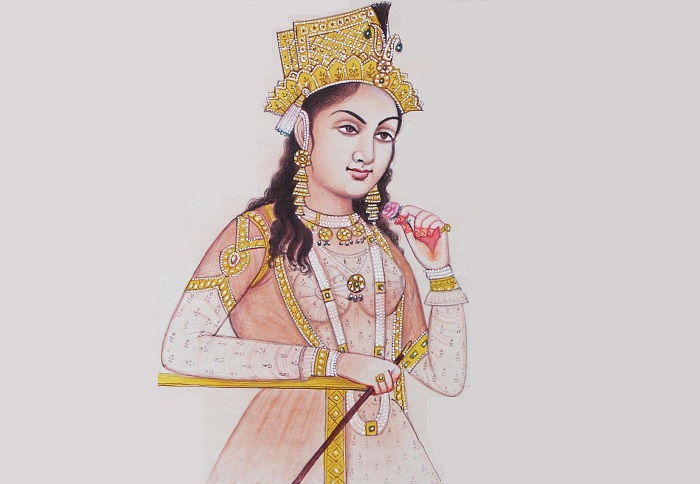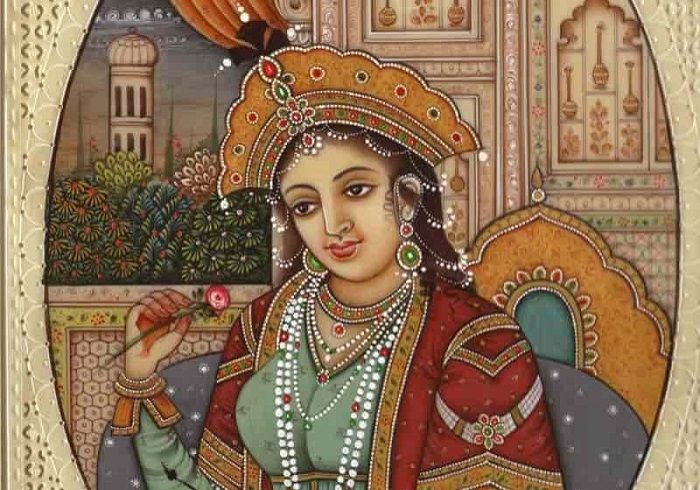Facts
Birth: 27 April 1593
Place of Birth: Agra, India
Death: 17 June 1631
Place of Death: Burhanpur, India
Father: Abu’l-Hasan Asaf Khan
Mother: Diwanji Begum
Siblings: Shaista Khan, Farzana Begum, Parwar Khanum
Spouse: Shah Jahan
Children: Six daughters and eight sons
Mumtaz Mahal was the chief consort of the Mughal emperor Shah Jahan. Though Mumtaz’s tenure was short-lived, she had a glorious professional life as she had complete control over Emperor Shah Jahan’s decisions, so much so that he would even pardon enemies and mitigate death sentences at the empress’ interposition. Mumtaz had a great influence on the affairs of the state as she served as the emperor’s principal adviser. She was also Shah Jahan’s trusted confidant and would often travel with his retinue, in spite of her frequent pregnancies. Mumtaz’s personal life was one of joy as she was the most prominent among the emperor’s wives. Since Shah Jahan was completely smitten with Mumtaz Mahal, he spent almost all his time with her, completely ignoring his other two wives in the process. Hence, Mumtaz enjoyed the glory of the Mughal Empire to the fullest. However, Shah Jahan’s intense love for her ultimately led to her death as she died at the age of 38 due to postpartum hemorrhage, while delivering her 14th child. Post her demise, Shah Jahan commissioned a mausoleum for Mumtaz, which would later be declared as one of the seven ‘Wonders of the World.’

Image Credit : https://anjanadesigns.blogspot.com/2014/08/facts-about-taj-mahal.html
Early Life
Mumtaz Mahal was born as Arjumand Banu Begum on April 27, 1593 in Agra, India. She was born to Diwanji Begum and Abu’l-Hasan Asaf Khan, who held high position in the Mughal Empire. While her father was a wealthy Persian noble, her mother was the daughter of Khwaja Ghias-ud-din, a Persian noble. Ghias-ud-din was also related to the royal family as he was the older brother of Nur Jahan, the Empress consort of Jahangir.
Mumtaz was well-educated and was fluent in Persian and Arabic languages. In fact, she was a poet, who often composed poems in Persian language. Mumtaz was considered a perfect example of beauty with brains at a very young age. Upon reaching puberty, she became the center of attention among many important empires. Since the tale of her beauty had reached far and wide, Jahangir had no hesitation in agreeing to her engagement with his son Shah Jahan.
Marriage to Shah Jahan
Mumtaz Mahal and Shah Jahan were engaged in a grand ceremony in January 1607. They got married five years later on April 30, 1612 when Mumtaz was 19 years old. The royal wedding was held in Agra, after which Shah Jahan conferred upon her the title ‘Mumtaz Mahal,’ which literally means the ‘Exalted One.’ Mumtaz was not Shah Jahan’s first wife as he was already married to Kandahari Begum in 1609. He also married Izz-un-Nissa Begum after marrying Mumtaz. However, his first and third marriage took place because of political reasons.
Apart from having a child each with his first and third wife, Shah Jahan did not have any intimate relationship with them. Shah Jahan’s love for Mumtaz and his disparage for his first and third wife was so great that it finds mention in ‘Iqbal Namah-e-Jahangiri,’ which is written by Motamid Khan, Shah Jahan’s official court chronicler. It also finds mention in historian Inayat Khan’s documentation of Shah Jahan’s relationship with his wives.

Image Credit : https://hindi.firstpost.com/culture/these-15-things-you-dont-know-about-mumtaz-mahal-61195.html
Shah Jahan’s extreme love for Mumtaz made sure she had a glorious married life. Not only did she lead an extremely lavish life, but she also had the complete attention of the emperor. ‘Khas Mahal,’ where she lived with Shah Jahan, was decorated with precious stones and pure gold, the kind of luxury Shah Jahan’s first and third wife could only hope for. Shah Jahan and Mumtaz Mahal were married for 19 years, during which Mumtaz gave birth to six daughters and eight sons, with seven of them dying in infancy.
As the Mughal Queen
Soon after ascending the throne in 1628, Shah Jahan declared Mumtaz as his chief empress. He also bestowed upon her a couple of titles, namely ‘Malika-i-Jahan’ and ‘Malika-uz-Zamani,’ which means ‘Queen of the World’ and ‘Queen of the Age’ respectively. Though she was the trusted adviser and close confidant of the emperor, she is not portrayed as having had the aspirations to political power. Nevertheless, she continued to play a key role in influencing the emperor’s decision in the affairs of the state. She would also often travel with Shah Jahan’s retinue in his military campaigns.
Mumtaz Mahal is described as a kind and generous empress as she would often influence the emperor in helping those in need, especially the poor. She would give donations and pensions to the daughters of theologians, pious men, and poor scholars. She also patronized many poets and scholars among others. A Sanskrit poet named Vansidhara Mishra eventually became Mumtaz’s favorite. Mumtaz would often play a decisive role in the emperor forgiving some of his enemies, including the commutation of death sentences. Apart from bestowing upon her the highest honor of the empire, Shah Jahan also gave her a yearly allowance of 10 lakh rupees as part of her housekeeping and travelling expense.

Image Credit : http://www.traveltourguru.in/mumtaz-mahal/
Death
Mumtaz Mahal was pregnant with her fourteenth child when she had accompanied her husband to Burhanpur. Shah Jahan and Mumtaz had visited Burhanpur as part of Shah Jahan’s military campaign, which was aimed at suppressing the rebellion of the governor of the Deccan, Khan Jahan Lodi. On June 17, 1631, Mumtaz suffered complications while giving birth to her child and after an unusually prolonged labor of nearly 30 hours, she breathed her last in Burhanpur. Postpartum hemorrhage, which is defined as excessive loss of blood during childbirth, was confirmed as the reason of her death. Her mortal remains were initially buried at Burhanpur in a garden named ‘Zainabad,’ which had been constructed on the banks of River Tapti by one of Shah Jahan’s uncles named Daniyal Mirza.
Since Burhanpur was never intended to be Mumtaz Mahal’s final resting place, her body was exhumed from ‘Zainabad’ on December 14, 1631. It was then transported to Agra in a golden casket. The funeral procession travelled 900 kilometers before reaching Agra, where Mumtaz’s body was interred in a small building. According to various sources, Shah Jahan was inconsolable after the demise of his favorite wife. In fact, he secluded himself and mourned her death for a year. When he showed up after a year, there were significant changes in his appearance as he had developed a hunch and his hair had turned grey. The loss had taken a serious toll on his health and it took several days for his daughter Jahanara Begum to bring him out of grief. Shah Jahan had already made up his mind to construct a suitable mausoleum for his wife. Hence, he commissioned the construction of Taj Mahal in 1632, which would take 22 years to complete. Mumtaz Mahal’s mausoleum would later go down in history as one of the most beautiful edifices ever built by mankind.
Taj Mahal
Considered by many as the epitome of love, Taj Mahal was built on the southern bank of Yamuna River in Agra. The mausoleum was completed in 22 years with Mumtaz’s tomb forming the central part of the 42 acre complex. Since Islam tradition prohibits one from decorating tombs, the mortal remains of Mumtaz was placed in a simple crypt, beneath the inner-most chamber of Taj Mahal. Inscriptions of the ‘Ninety Nine Names of God’ can be seen on the sides of the tomb. Many believe that Taj Mahal represents the beauty of Mumtaz Mahal, a theory which is supported by many scholars, given the elaborate design and feature of the building. The inner-most chamber was originally built to house only a single tomb. However, upon Shah Jahan’s death on January 22, 1666, his son Aurangzeb did not want to build a separate tomb for him and hence had his mortal remains buried next to Mumtaz Mahal’s tomb.

Image Credit : https://en.wikipedia.org/wiki/Taj_Mahal
Taj Mahal went on to become one of the most beautiful edifices in the world. Its dome, which surmounts Mumtaz Mahal’s tomb, is nearly 35 meters high. With more than seven million visitors visiting the site annually, Taj Mahal is one of the most popular edifices in the world. It is considered as one of the finest examples of Mughal architecture. In 1983, Mumtaz Mahal’s mausoleum was declared as ‘UNESCO World Heritage Site’ and in 2007 it was included in the list of ‘Seven Wonders of the World.’ As the final resting place of both Mumtaz Mahal and Shah Jahan, Taj Mahal is considered extremely important for its historical significance alone. Along with its obvious significance, the structure’s breathtaking design and beauty make it stand out from a host of other man made wonders.


